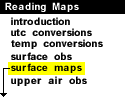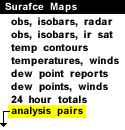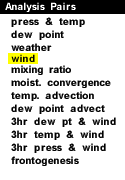
|

Example Pressure Wind Distribution
This panel depicts sea-level pressure and surface wind vectors. This chart is useful for finding fronts and high and low pressure systems.
The blue arrows represent wind vectors. Wind vectors show wind direction and wind speed. The arrows point in the direction the wind is blowing and the longer the wind vector the stronger the wind. From the map above you can easily find warm, cold, occluded, and stationary fronts. Fronts are usually located in areas where winds come together and change direction. Low and high pressure systems can also be located from the map above. Winds around a low pressure system move counter-clockwise (cyclonic) and in towards the center. While winds in high pressure move clockwise (anticylonic) and out away from the center.
The solid white contours represent pressure contours (isobars) in millibars. The isobars have an interval of 4 millibars. The wind speed is directly related to the distance between the isobars, The closer they are together, the stronger the pressure gradient, and the stronger the wind.
This image was chosen because it shows the conditions just preceding a devastating tornado outbreak on July 2, 1997. Over a dozen tornadoes killed eight people in the states of Michigan, Indiana and Ohio. The dryline (coldfront) is located in the pressure trough and where the winds switch from southerly to westerly.
For more information on how pressure affects the weather go to our pressure module.

weather |
|

mixing ratio |




